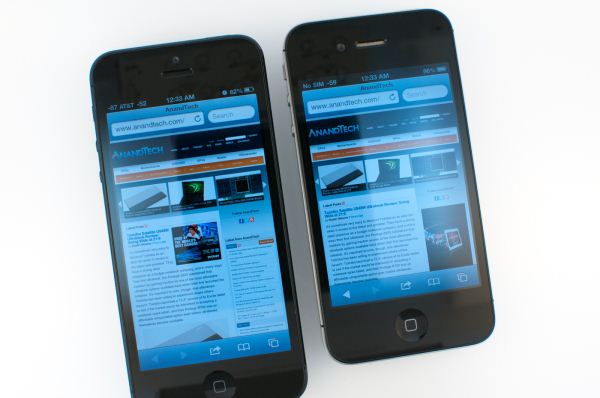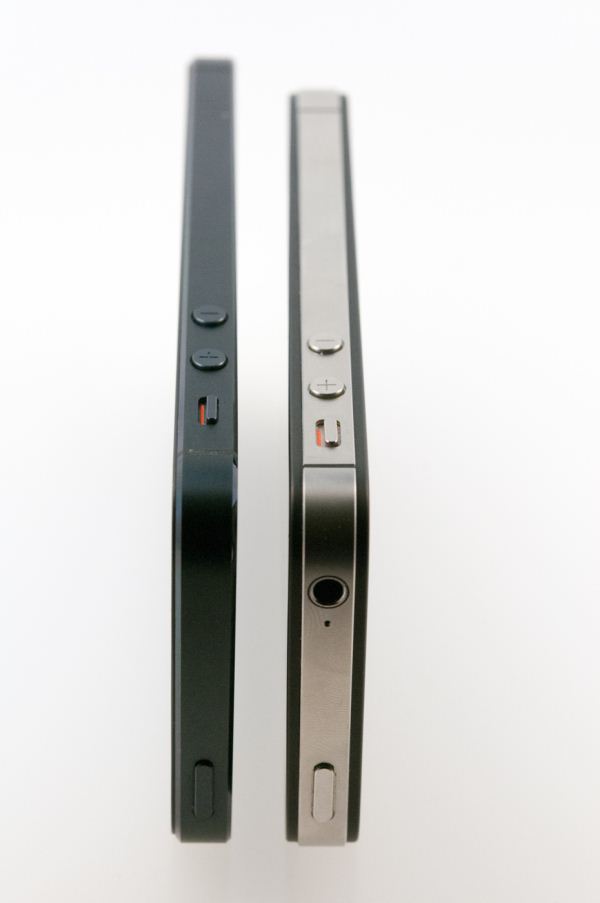The iPhone 5 Review
by Anand Lal Shimpi, Brian Klug & Vivek Gowri on October 16, 2012 11:33 AM EST- Posted in
- Smartphones
- Apple
- Mobile
- iPhone 5
The last significant redesign of the iPhone platform came in 2010 with the iPhone 4. It was an update that literally touched all aspects of the device, from SoC to display to baseband and of course, chassis. Last month’s launch of the iPhone 5 is no different in magnitude. The sixth generation iPhone makes some of the biggest changes to the platform since its introduction in 2007.
Visually the device begins by evolving the design language of the iPhone 4/4S chassis. From the launch of the iPhone 4 it was quite obvious that Apple had picked a design it was quite proud of. Thus it’s not too surprising that, from a distance, the iPhone 5 resembles the previous two iPhone models. We’ll get into material differences shortly, but what make the iPhone 5 design such a radical departure is its larger display.
All previous iPhones have maintained the same 3.5-inch, 3:2 aspect ratio display. With the rest of the world quickly moving to much larger displays, and with 16:9 the clear aspect ratio of choice, when faced with the decision of modernizing the iPhone platform the choice was obvious.
The iPhone 5 embraces a taller, 4-inch, 16:9 1136 x 640 display opting to lengthen the device instead of increasing its area in both dimensions. The result is a device that is distinctly an iPhone, albeit a modern one. The taller display doesn’t do much to make desktop web pages any easier to read as a result of the width staying the same. Those longing for an HTC One X or Galaxy S 3 sized device running iOS are out of luck. Reading emails and typing are both improved though as there’s now more room for lists and the keyboard no longer occupies as much of the display. The taller device can be more awkward to use if you have smaller hands, but the added screen real estate is honestly worth it. Once you get used to the iPhone 5’s display, going back to the older models is tough.
The taller chassis went on a diet as well. The iPhone 5 is now considerably thinner and lighter than its predecessor, which is yet another factor that contributes to it feeling more modern.
Internally the device changes are just as significant, if not more, than those on the outside. The iPhone 5 includes LTE support, which in areas where LTE networks are deployed can be enough reason alone to warrant an upgrade.
The iPhone 5 also includes a brand new SoC from Apple: the A6. For the first time since the introduction of the iPad, Apple has introduced a major branded SoC on an iPhone first. The iPhone 4 used the A4 after it debuted on the iPad, and the 4S picked up the A5 months after the iPad 2 launched with it. The A6 however arrives first on the iPhone 5, and with it comes two of Apple’s first, custom designed CPU cores. We’ve always known Apple as a vertically integrated device and software vendor, but getting into CPU design takes that to a new level.
| Physical Comparison | ||||
| Apple iPhone 4S | Samsung Galaxy S 3 (USA) | HTC One S | Apple iPhone 5 | |
| Height | 115.2 mm (4.5") | 136.6 mm (5.38" ) | 130.9 mm (5.15" ) | 123.8 mm (4.87") |
| Width | 58.6 mm (2.31") | 70.6 mm (2.78") | 65 mm (2.56") | 58.6 mm (2.31") |
| Depth | 9.3 mm ( 0.37") | 8.6 mm (0.34") | 7.8 mm (0.31") | 7.6 mm (0.30") |
| Weight | 140 g (4.9 oz) | 133g (4.7 oz) | 119.5g (4.21 oz) | 112 g (3.95 oz) |
| CPU | Apple A5 @ ~800MHz Dual Core Cortex A9 | 1.5 GHz MSM8960 Dual Core Krait | 1.5 GHz MSM8260A Dual Core Krait | 1.3 GHz Apple A6 (Dual Core Apple Swift) |
| GPU | PowerVR SGX 543MP2 | Adreno 225 | Adreno 225 | PowerVR SGX 543MP3 |
| RAM | 512MB LPDDR2-800 | 2 GB LPDDR2 | 1 GB LPDDR2 | 1 GB LPDDR2 |
| NAND | 16GB, 32GB or 64GB integrated | 16/32 GB NAND with up to 64 GB microSDXC | 16 GB NAND | 16, 32, or 64 GB integrated |
| Camera | 8 MP with LED Flash + Front Facing Camera | 8 MP with LED Flash + 1.9 MP front facing | 8 MP with LED Flash + VGA front facing | 8 MP with LED Flash + 1.2MP front facing |
| Screen | 3.5" 960 x 640 LED backlit LCD | 4.8" 1280x720 HD SAMOLED | 4.3" 960x540 Super AMOLED | 4" 1136 x 640 LED backlit LCD |
| Battery | Internal 5.3 Whr | Removable 7.98 Whr | Removable 6.1 Whr | Internal 5.45 Whr |
There’s a lot to talk about when it comes to the new iPhone. Whether it is understanding the architecture of the A6 SoC or investigating the improved low light performance of the iPhone 5’s rear facing camera, we’ve got it here in what is easily our most in-depth iPhone review to date. Let’s get started.












276 Comments
View All Comments
youwonder - Wednesday, October 17, 2012 - link
I find it kind of ...odd that the S3 has a much larger battery than the one X and the same SoC yet posts significantly worse LTE browsing numbers, and is the only phone using LTE to get worse results with it than using 3G(granted that is the international vers, doesn't look like they had time to do testing on the AT&T or verizon variant running 3G). Does the samoled screen really draw THAT much more power than an LCD? also there's this which makes me wonder more:http://blogs.which.co.uk/technology/smartphones/be...
Of course, I don't respect these guys as much as anandtech when it comes to accurate results, and they did things much differently (broadcasting their own 3g signal and putting all phones on max brightness), but still the odd results here make me wonder if a small mistake wasn't made.
Zink - Wednesday, October 17, 2012 - link
Max brightness gives the gs3 an advantage because its screen is so dim. The other phones are using LED lighting as well but they go much brighter and have to shine through the LCD panel.youwonder - Wednesday, October 17, 2012 - link
Good point, I guess it's mostly just me wondering why the GS3 LTE variant posts such horrible numbers even compared to it's 3G version when anand specs a good amount of time explaining why the opposite is true.phillyry - Sunday, October 21, 2012 - link
Don't know why but it does tank on LTE.rarson - Wednesday, October 17, 2012 - link
I'm getting so sick and tired of seeing the word "literally" injected into all sorts of sentences that it doesn't belong in. This word only needs to be used when describing something literal. It's not a synonym for "really" (not yet, anyway).andykins - Wednesday, October 17, 2012 - link
Alright, language purist. :Pjoos2000 - Thursday, October 18, 2012 - link
http://theoatmeal.com/comics/literallyphillyry - Sunday, October 21, 2012 - link
Great link. That's too funny - literally!dfonseca - Wednesday, October 17, 2012 - link
On the last page, section "Final Words" / "iPhone 5 Device Conclusions", it's written:> At a high level, the iPhone 5’s cameras appeared to be some of the least unchanged elements of the new device however in practice the improvements are significant.
"Least unchanged" means "most changed." It should probably say "most unchanged," or "least changed."
Nice review, kudos to all authors.
mattlach - Wednesday, October 17, 2012 - link
I had the original iPhone, followed by the iPhone 3G and then the iPhone 4, and just switched to a Samsung Galaxy S3 in July.When the original iPhone came out, while it was the first to do what it did - and that's why I bought it at its steep no-contract introductory price - it wasn't exactly revolutionary, everything in the market was moving in this direction, but it was pretty well executed and nothing else did it at the time.
I upgraded to the 3G on launch, as I thought the edge speeds were dreadful, but was disappointed, as the phone wasn't fast enough to take advantage of 3G, and AT&T's 3G was pretty mediocre anyway. It didn't get important features its competitors had, like copy and paste until very late in the game, and I started to think that I should have gotten an Android phone instead.
By the time I got the iPhone 4, I was tired of my slow 3G experience and just wanted an upgrade to something faster. The iPhone 4 was a good upgrade, but I really only got it because I didn't like AT&T's Android offerings at the time. I had been thinking about going to Verizon and getting an Android for some time. The 3G should have been my last iPhone, it was a mistake to buy the 4.
Having realized my mistake, I waited 2 long years with the 4 until I could finally get out of my AT&T contract and go to Verizon and get a GS3, and it felt great.
The additional freedom of what I run on my phone, not being controlled by Apple and their agenda as to what makes it into the App store, and the fact that I finally no longer had to have iTunes installed on my computer were fantastic.
My computer has been iTunes free for 3 months now, and it feels great!
I was concerned for a while that once the iPhone 5 was released, they would come out with something that would make me regret my choice of the GS3, but it turns out they didn't.
I'll likely never buy anything Apple again. It feels like a huge relief to say that.